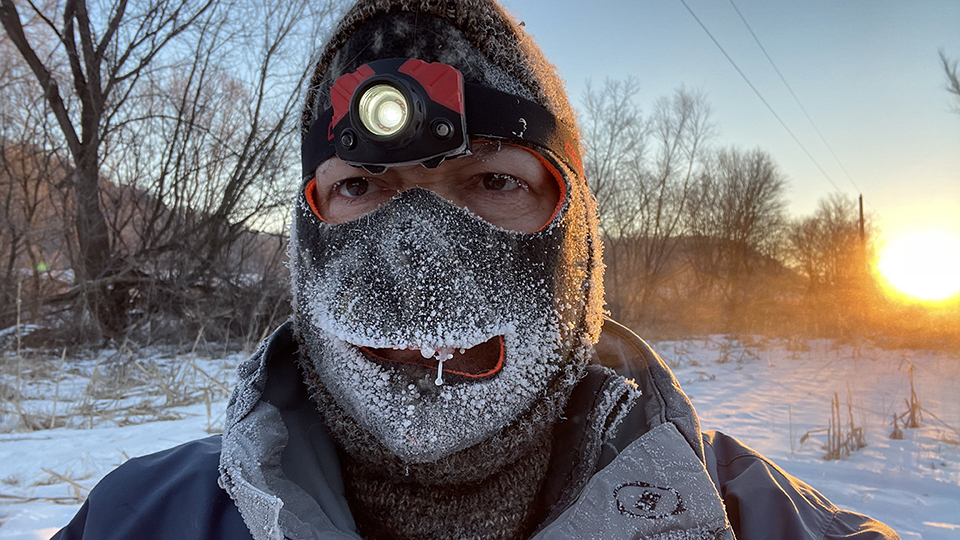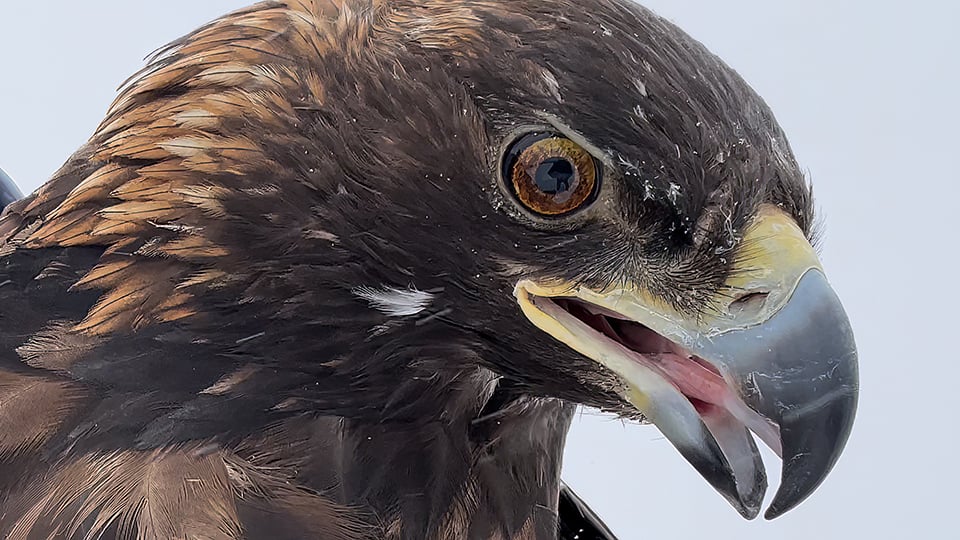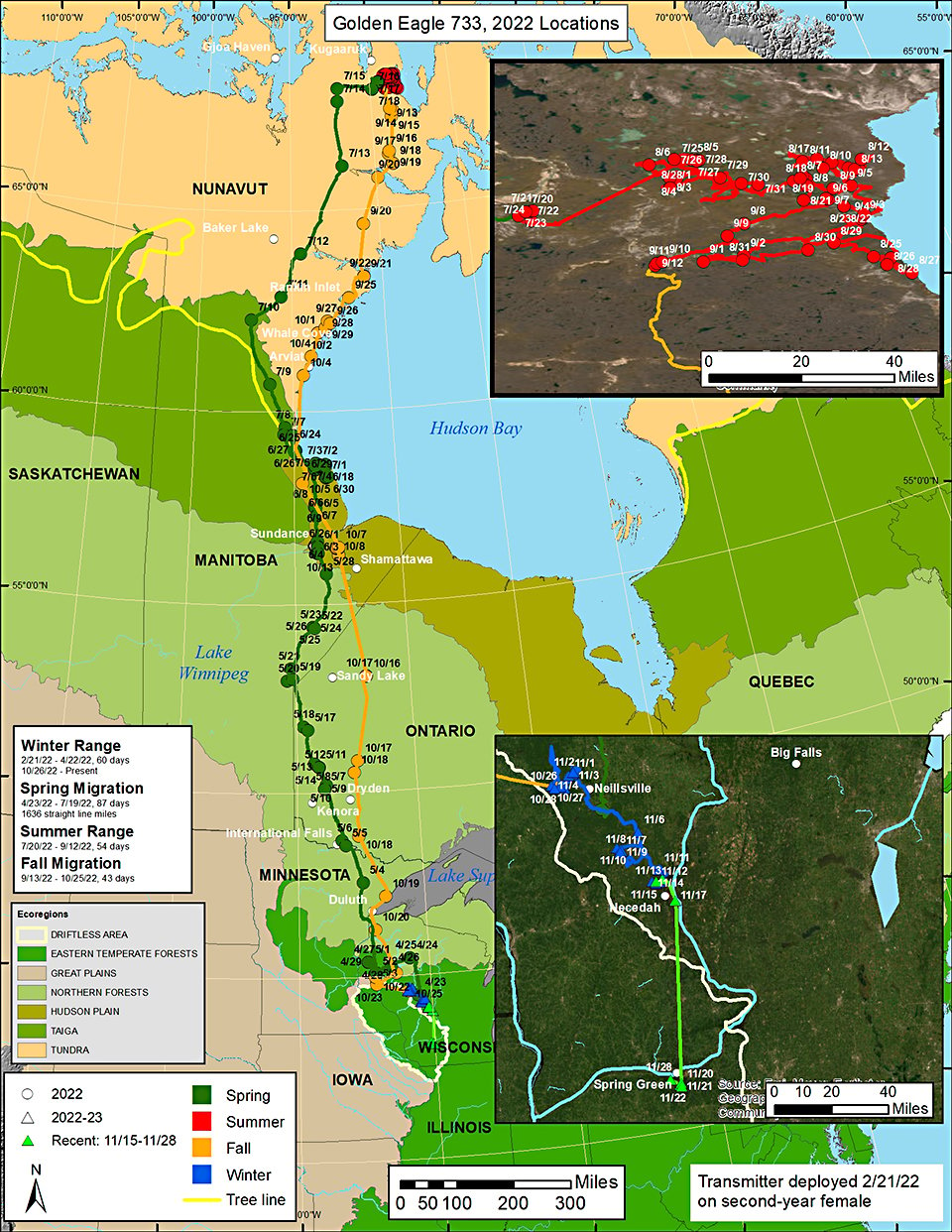We initiated a Golden Eagle research study in January of 2022 and are monitoring wintering Golden Eagles in the Driftless Area to learn more about their movement on their winter and summer ranges. We are looking at potential nest locations, seasonal migration patterns and timing, and route fidelity. Research is being conducted under the guidance and permits of RRP’s Jeff Worrell, former director of the National Eagle Center, and raptor biologist Brett Mandernack. This year we trapped two Golden Eagles, one mature female and one second year female, and fit them with satellite transmitters to learn more about these mysterious winter visitors!

Collecting data: Brett Mandernack measures a Golden Eagle’s tarsus.
Golden Eagles are one of the world’s largest eagles. Shorter but heavier than Bald Eagles, adult and immature eagles are a rich chocolate brown, with feathered or ‘booted’ legs, a lustrous golden nape, and long black talons that look like meat hooks. They are remarkably elusive for such large birds, but a sharp observer might spot one or two in the bluffs and steeply wooded draws of the Driftless Area. We were thrilled when Jeff Worrell and Brett Mandernack proposed a Golden Eagle research project in 2021, especially since little is known about the eastern Golden Eagle population wintering in the Upper Midwest. After a year of planning to determine transmitter type, locating trapping sites, securing lure birds, and refining our capture technique, we assembled a trapping team and went to work.
Catching Golden Eagles: Not an easy task!

Golden Eagles don’t care if it is -25F. John on a wintery morning
Catching Golden Eagles can be frustrating. We trap from January to early March, which means serious cold and deep snow. Golden Eagles don’t care that it’s -25F, that steep, icy slopes are hard to navigate in the dark, or that fingers don’t work very well in the bitter cold. Jeff put a lot of detective work into finding Golden Eagles, but the species isn’t especially common or predictable, so a challenging pre-dawn hike in subzero weather might be followed by a day of sitting and hoping that an eagle comes down to our net. But as we admired (and sometimes cursed) Golden Eagles high up on their rocky driftless perches, we came to a true appreciation of this amazing species: a species that lives and thrives in conditions that our fragile human selves would perish.

Head profile. Note the distinct golden nape
Setting traps is hard, but the real work begins once a Golden Eagle is in the net! Our trapping team needs to get to the site quickly and free the eagle without hurting it, losing it, or encountering its three-inch long talons and bone-crushing grip. Once the eagle is out of the net, we hood and leash it for safety and take photos and measurements, including weight, wing chord, tail length, and tarsus thickness. We band the eagle, (9 for a small male, 9C for a big female), attach the transmitter, and release it where we caught it. At that point, data collection takes over! We use a tracking device that can connect with cellphone towers or satellites, which results in a remarkably rich data set. We know our eagles’ locations, speed, altitude, activity levels, external temperatures, battery information, and area weather information.
What we’ve learned…

November 29, 2022: Golden Eagle 733
What did their summers look like? Both of our eagles wintered in the Driftless Area, flying north in April and May, respectively. Both summered above the arctic circle about 1600 miles north of their wintering grounds, although the adult summered further north than her immature counterpart. As if their massive feet, adaptability, hardiness, and intelligence weren’t enough, they were remarkably fast for such large birds! We documented them traveling over 200 miles in a single day, maintaining an average speed of 33 miles per hour for six hours straight, flying at elevations of over 5,000 feet, and stooping at speeds of 90 miles per hour!
Ryan Schmitz also made some important connections with local people, so we have context for their lives in Nunavut: what they might be eating, what their habitat looks like, what else people are seeing, and how they survive in the rugged yet lovely environment above the arctic circle.
As of this writing, the immature female eagle is back. We have transmitters to deploy and look forward to learning more about these beautiful and enigmatic eagles. If you’d like to learn more about the eagles, visit our Golden Eagle page at https://www.raptorresource.org/learning-tools/golden-eagles/. To read John’s eagle trapping account, follow this link: https://www.raptorresource.org/2022/03/22/golden-eagle-trapping-in-the-driftless/.
We need more eyes in the sky for our Driftless Golden Eagle program. If you see Golden Eagles, or believe you have them on your land in the Driftless area of Wisconsin, Minnesota, or Iowa, please contact Amy Ries at [email protected], or text 621-237-5793. We would love to learn more!
 The Raptor Resource Project
The Raptor Resource Project The Raptor Resource Project
The Raptor Resource Project